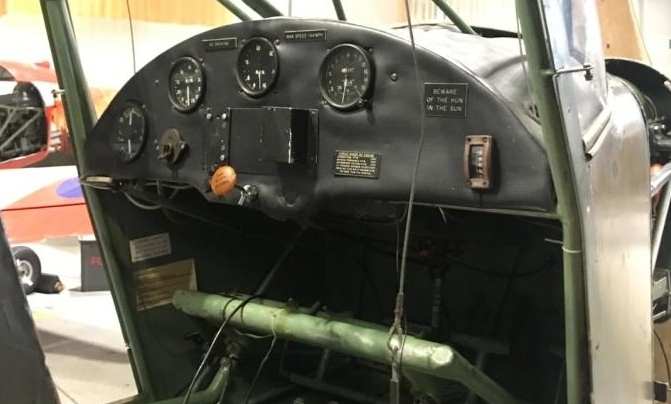In 1942 when our Auster Mk1 was manufactured, there was only one aim and that was to fully support the war effort. The aircraft were simple, the mission straightforward and back then, technology only had a small part to play in operating safely and effectively. The cockpit dashboard pictured below shows there was just enough instrumentation for the pilot to keep the aircraft pointing in the right direction and at the right height while keeping an eye on how the engine was performing.
Fast-forward 80 years and we have a hugely different operating regime and a real need to play nicely with other aircraft in and around our bit of the airspace. Couple this with our present cockpit needing quite a lot of tender loving care and we have a major upgrade project for our little Auster.
The challenge is to sympathetically embed a VHF radio system and a microwave transponder so we can be seen (electronically) and speak to other aviators and ground stations – all things taken for granted these days. The VHF and Transponder modification beyond the cockpit dashboard will be the subject of a later blog. So for now we focus on the difficult task of inserting modern equipment while keeping our 1940’s era aircraft from looking like something new from the latest Lear-Jet Aircraft Collection.

The original 1942-era cockpit dashboard
The old dashboard came out easily and was quickly conditioned as being somewhat past its sell-by date. The space behind the dashboard needed to accommodate the new instruments is very limited, largely due to the fuel tank being right in the way! Recessing the VHF and Transponder instruments into the dashboard where they can be safely used by the pilot was challenging!

Not much room behind the dashboard due to the fuel tank location

The original cockpit dashboard ready for replacement
So, armed with his Carpenters Tool Roll and an extensive set of needle files, our engineer for the job (Dave) set about creating a new instrument installation for our new plywood cockpit panel (made by Jay). The design (credit to Phil and his amazing drawings) places the two new instrument heads in the centre of the new dashboard – and just to keep it sporty, this is right in front of the fuel tank location. We additionally wanted to install a period Voltmeter giving both visual balance to the installation and a new (critical) source of information for the pilot. The voltage-remaining issue becomes clear when we note this engine does not have any form of electrical generation so the total-loss battery system that will drive the new instruments needs a condition-indicator. Add in the need for a pair of toggle switches and Dave was truly faced with fitting a “Quart into a Pint Pot”.


Sheet alloy turned into exquisite instrument mounting consoles – by Dave
Many hours of manufacturing from scratch and finding just the right anchor nuts and fixings – and filing down numerous tiny rivets to the right length, we have a new cockpit ready to go for a test installation.
There are still many hours of finishing left to go and we need to complete the associated modifications around the aircraft to support the new VHF system and Transponder. This has been a massive step forward in the reconditioning journey for our Auster – and we now have a bit of 21st Century tech beautifully crafted into an age-sympathetic rebuild of a 1940’s cockpit.

Testament to Dave’s skills and Phil’s planning, it only took bit of fettling to the wood panel and a tweak to the rear avionic plug mount (fuel tank in the way again!) and the new dashboard fits perfectly.

